This essay originally was published on November 17, 2022, with the email subject line "CT No. 142: Ditch Tactic-level SEO."
Everyone who publishes online thinks they know SEO. But for seasoned practitioners, hearing inexperienced writers and marketers share SEO tips usually results in a facepalm.
- You think SEO is adding keywords to an individual webpage after the content has been written.
- You think your web developer will execute “SEO” on their own, without any specific research.
- You think that if a website fails to optimize titles and meta descriptions, it will never be found in search.
- You think checking Google autocomplete, Google Trends or Answer the Public for new search terms is keyword research.
- You think your content is performing “fine” without knowing any actual numbers of how what you publish actions channels affects bottom-line business performance.
- You optimize URL slugs by stuffing them with keywords.
- You consider “SEO content” or “blog content” to be something wholly different than “website content.”
- You think digital content strategy begins and ends with voice, tone and editorial correctness.
- You spend time thinking about what goes in the "meta keywords" field.
- You think most new website visitors are referred from social channels or newsletters.
- You think watching keyword rankings move up and down is a business-critical activity.
- You think there is such a thing as “SEO ads” — as found this otherwise authoritative post by the experts of measurement and media strategy at Nielsen.*
Although it’s been years since the above tactics have significantly moved the needle for content businesses, I continue to read “expertise” by digital strategists at large news organizations claiming, “SEO is for driving traffic!” It’s hard to avoid hearing brands trumpet an SEO and social content strategy that consists solely of “Be on TikTok because Google said that’s where Gen Z searches now!”
If you learned digital strategy simply from “being online,” reading Reddit, cruising LinkedIn Learning, or watching YouTube videos, you likely have no idea how the behavioral dynamics of digital audiences work. If you post without understanding results, or if you learned from college professors or legacy news organizations, it’s likely you learned outdated, impractical SEO and content tactics.
Like fixing all the serial commas but missing the major factual errors in an editorial review, post-publication tactical SEO may seem "correct" but burns resources on minutiae and misses the point of building audience trust.
So let’s set the record straight with five truths I’ve learned about digital content strategy across my career:
- SEO is an organic growth approach, meaning that it is not advertising. You can’t pay for it; you can only intentionally structure your content so it is more easily found.
Search ads are called PPC, paid search or CPC. SEO and PPC combined are called SEM, or search engine marketing. Organic optimization/SEO can certainly be impacted by advertising! But using the phrase “SEO ads” or conflating SEO with paid media in any way is a clear indicator that you don’t know what you’re talking about. - Digital traffic alone drives no revenue and has no impact on business performance unless you are selling impression-based advertising, and even then it’s pennies of ROI compared to the lifetime value and connection with a potential audience member.
- In 2022, topic expertise and website structure have more impact on SEO than any individual keyword- or page-based tactic. Building “SEO content” works kindof, but it’s a wasteful, clunky approach to audience development.
- Across every industry, social media hasn’t provided significant percentages of new users to high-quality websites since the big Facebook algo change of January 2018. Social media has many content and marketing merits, but organically attracting new users to your website content is not high among them.
- A true digital content strategy matches audience needs with business goals (aka $$$$$) at a macro level. Voice and tone, URL slugs, keyword maps, and title tags are small tactical parts of that strategy, but not the whole kit and caboodle.
From low-impact SEO tactics to a sophisticated audience acquisition strategy
In a sophisticated audience acquisition strategy, search optimization is a long-term, comprehensive digital effort to attract audiences actively seeking trustworthy information on topics about which your company or brand has authority. It’s organic, meaning that you’re not paying for your audience’s attention; you’re letting them discover your brand through their own efforts.
As an audience-building discipline, organic search in the 2020s is not about chasing shiny objects, adding keywords where they don’t belong, or bopping around platform to platform in search of an audience. It’s not about adding endless AI-generated blog pages to your website with zero originality. At minimum, organic acquisition takes audience research, competitive analysis, and a consistent content approach.
And at best, it’s a ground-breaking way to build topical influence with an audience that values your perspective, your brand and your business. An organic audience acquisition strategy is worth more to your content business than a bookstore endcap, a newsstand, a series of email pleas, and a viral Tweet combined.
The role of SEO in growing an audience who trusts your brand
Search optimization/SEO makes your content readily available in the channels where your audience wants to find you. As I demonstrated a few weeks ago, usually that channel is Google, simply because of market penetration and the fact that search has historically been the most consistently high-quality traffic for websites.
But a true organic acquisition strategy is about making your content discoverable: on Instagram or TikTok, DuckDuckGo or Naver—wherever your most valuable audience spends their time.
If your business is content, examine whatever role “driving traffic” has in your strategy and replace it with “finding an audience.” The role of organic search, aka SEO, aka how you show up on the most populated places and in the most crucial resources of the internet, is to introduce new audiences to your brand when they are seeking trustworthy information.
What is organic audience acquisition?
In the broadcast days, attracting audiences meant a great cover photo or killer headline for the newsstand, some creative splash to catch attention and inspire purchase. It meant buying an ad in another publication or paying for a sponsorship. Or it meant buying a mailing list and direct mailing postcards, coupons and brochures to your intended audience.
Search and social algorithms provide a new method of discovery: organic visibility, or the ability to attract audiences via free-to-use, free-to-post channels where your audience already lives. In the age of algorithms, audience acquisition means building organic visibility on non-branded topics in your target digital channels.
SEO and organic reach are often misunderstood by publishers and marketers because organic acquisition has a new set of contextual rules. The closest analog version is the public library, which is not an equivalent channel at all!
Why focus on organic acquisition separately from paid?
Organic acquisition (SEO, hashtag research, posting consistency) attracts a higher quality audience than paid visibility (PPC, paid social). Ask any cross-channel strategist: Paid works quickly, but organic is a long-term, higher value play.
Audiences worldwide take organic content more seriously and trust it more often, conferring higher value. Consult brand trust research from the past fifty years: contemporary audiences widely believe paid ads are less trustworthy than organically surfaced content.
That’s why trade regulators and Redditors alike make rules about paid sponsorship disclosures: when an audience knows a recommendation has been paid for, it becomes less valuable. Organic content success means outside algorithmic sources think the content is worth surfacing.
So how do you make your content more organically discoverable and trustworthy so audiences will find you…and then come back for more?d you…and then come back for more?
Moving from SEO to organic audience acquisition
Here are my top three tactics to build a more sophisticated organic audience acquisition strategy:
1. Start with facts about your audience’s behavior.
How well do you know your audience, really? And what’s the ideal relationship that you want them to have with your content?
Too often, I work with teams that technically have data and brand documents. They have segments and personas and funnels and keyword research and surveys and anecdotes and… they still can’t tell me how their content maps to any of that data. If an audience persona listed a career in “information technology,” the team spins up a page or three about “IT,” but none of the team members can identify whether that persona was built on data (and not “informed guessing,” on which many marketing personas are built) or whether that potential audience even reads the web.
Or they might say, “We know people like podcasts so we’re adding one to grow our audience.” They won’t stop to question whether their audience of email and website readers would also want to listen to the same content, or consider how adding a channel with a completely different audience acquisition strategy will fit into their existing workflow.
Instead of blindly creating page after page of “SEO content” or launching channels your team can’t support, break it down to what your audience needs and what behavior you want to inspire.
Follow this template if you need guidance for developing an organic acquisition approach:
- For a news organization: We know that our audience uses search to find facts about how well their local government is working. We can best serve them if they find our non-branded topic pages in search when they seek information about our local city council.
- For a content marketing organization: We know that our audience listens to podcasts when they do work they consider “boring.” We can best serve them if they find a show that inspires them when they search for podcast recommendations.
- For an independent photographer: We know that our audience browses Instagram when they are having down time. We can best serve them if they find our clever takes on family photos when they want to discover #familyphotographyideas.
Related content from the archives:

2. Optimize for topics across channels, not keywords on individual pages or hashtags on individual posts.
Both search and social digital publishing tools build authority or equity over time. The more you post about a topic and connect that content with high-quality links and clear context, the more an algorithm, an audience, or an audience-driven algorithm considers your content to be authoritative. It’s like beat reporting: you pick a topic and own that coverage.
Your topical content will be most discoverable when it is informed by audience data, such as a combination of keyword research, audience surveys, and website behavioral data. You may even want to create content pillars, or macro-topics mapped to brand values, to organize and measure your strategy.
Google and other search engines have long been smart enough to understand topic-oriented search. If a page is very high quality and discoverable, it will appear in organic search for many variations on a topic, not just a specific topic keyword. Optimizing for topics means that you’re no longer trying to “rank” for an individual keyword. (I’ve long seen that keyword rank tracking is a giant waste of effort and often negatively impacts SEO because teams are so focused on rank, they don’t execute other tactics that move the needle.)
Instead, you’re trying to improve organic visibility on a topic where you have authority. You’re posting regularly about your topic of choice on the channels where your audience finds information, answering the questions that they have. You’re giving them natural pathways so, once they’ve read one piece of content on a topic, they can easily find another that’s more in-depth. You’re building equity on multiple channels so they mirror each other. When your audience sees your brand posting facts about a topic on Instagram, they should be able to find those facts on your website easily when they search Google for the same language you used in your post.
Building data-informed topical authority across channels positions your brand as the expert on your target topic—whether they pertain to current events or SaaS software.
Related content from the archives:


3. Structure all content for discovery, considering both first impressions and return visits.
Far too many companies and publishers still focus only on the homepage or brand new content without realizing that, on authoritative websites with high-quality content, the majority of new users first arrive on more content-heavy, deeply linked pages.
If you don’t believe me, consult your web analytics. Pull up your list of top landing pages and filter for new users or first visits. If you’ve been publishing consistently for more than two years, it’s highly likely your homepage accounts for fewer than 50% of unique users. Your other pages combined will attract far more new visitors.**
Because organic search equity builds over time, it’s likely these most authoritative pages are older. And each page, whether it’s a brand new article or something old that’s become a hit, should be optimized for:
- New visitors who have never heard of your brand before
- Previous visitors who know about your brand but do not visit your website regularly
- Returning audiences with strong brand affinity who visit your website to find all newly published content
Optimizing for these different mindsets and behaviors means putting yourself in each reader’s place both when you’re designing and again when you hit “publish.” If a brand new user reads that one-off “SEO content” and doesn't see a call to action to subscribe, doesn’t understand the purpose of the page, is overwhelmed by ads, and thinks the website is badly designed, they might not click through when they see your domain in search again.
Or if they know your brand might have expertise in a topic area but can’t find that content through navigation or on-site search, they might succumb to frustration and avoid visiting in the future. This behavior is common on sites that have all the newest content piled high in a “blog” or “resources” section with zero topical navigation.
It’s also one of the big drawbacks of platform-based newsletters: content lives in a most-recent pile, without any guiding organization for archival purposes. If it’s not evident where your highly relevant, topical content lives after its debut, it becomes lost forever in a sea of disconnected posts, its expertise never discoverable from readers who seek it.
Or if they absolutely love your content but can’t easily access or preview the latest and greatest, they’re not likely to scour the website to find it. It’s a common behavior on product-led sites, which are often so focused on conversion rate optimization they forget the strategic purpose of relevant content: to build ongoing brand affinity with repeat visits. No point in publishing regular content if it’s not easily previewed on your homepage!
*And if you don’t know how to execute this in web analytics, I recommend Understanding Google Analytics 4.
Related content from the archives:


Making impactful changes for organic audience acquisition
Here’s my plea to all content professionals, whether you are a big believer in SEO or a lingering algorithmic skeptic:
- In 2023, ditch the keyword approach in favor of topic optimization, spend less time on tedious low-impact optimizations, and take big strides to make your content more discoverable.
- Question your assumptions about your audience, especially if you don’t know where your personas came from, if you’re not regularly looking at analytics, or if you haven’t conducted a focus group in 10 years.
- Devote more time to gathering data about your audience and structuring your content so your ideal audiences can find it. Your brand affinity—whether for your content marketing or your publishing—will follow.





